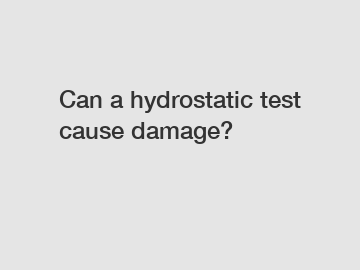Can a hydrostatic test cause damage?
Can a Hydrostatic Test Cause Damage?
Hydrostatic testing is a method used to detect flaws or weaknesses in materials such as pipelines, cylinders, and tanks that are designed to hold liquids or gases under pressure. By subjecting these structures to high levels of internal pressure, it is possible to identify any potential leaks or failures that could cause serious harm or damage. However, while hydrostatic testing is generally considered a safe and reliable procedure, there are circumstances where it can potentially cause damage. In this article, we will explore the potential risks associated with hydrostatic testing and discuss how to minimize them.
I. What is a hydrostatic test?

A hydrostatic test involves filling a structure with a liquid, typically water, and gradually increasing the pressure to the specified test level. This allows for an examination of the structure's integrity by monitoring any changes in pressure or the appearance of leaks. It is an essential quality control measure to ensure the safety and reliability of pressure vessels and piping systems before they are put into service.
II. Potential risks of hydrostatic testing.
While hydrostatic testing is generally a safe process, there are potential risks involved, including:
1. Over-pressurization: Applying excessive pressure during a hydrostatic test can potentially cause damage, such as rupturing or bursting of the structure being tested. It is crucial to ensure that the test pressure does not exceed the maximum allowable working pressure (MAWP) specified by the manufacturer.
2. Corrosion and material degradation: Constant exposure to water during a hydrostatic test can lead to corrosion and material degradation, particularly for older or poorly maintained structures. This can weaken the integrity of the system, increasing the risk of failures in the future.
III. Minimizing the risks.
To minimize the potential damage associated with hydrostatic testing, several precautions should be taken:
1. Accurate pressure calculations: Before conducting a hydrostatic test, it is essential to calculate the appropriate test pressure based on the MAWP and design standards. Using accurate pressure calculations ensures that the test does not exceed the limitations of the structure.
2. Thorough inspections: Before a hydrostatic test, conduct a comprehensive inspection of the structure to identify any existing flaws or areas of concern. If any defects are found, they should be addressed and repaired before proceeding with the test.
3. Controlled pressurization: Ensure the pressure is gradually increased to the desired test level, allowing time for the structure to stabilize. Avoid sudden pressure changes that could lead to damage or failures.
4. Monitoring and supervision: Continuously monitor the pressure and condition of the structure during the test. This allows for immediate identification of any issues or abnormalities, enabling prompt corrective action.
5. Post-test inspections: After completing a hydrostatic test, conduct thorough inspections to detect any damage that may have occurred during the testing process. If any damage is found, appropriate repairs or replacements should be carried out before putting the structure back into service.
In conclusion, while hydrostatic testing is generally a reliable and effective method for identifying weaknesses in pressure vessels and piping systems, it does carry some potential risks. To minimize these risks, accurate pressure calculations, thorough inspections, controlled pressurization, continuous monitoring, and post-test inspections are essential. By following these guidelines, the potential for damage can be significantly reduced, ensuring the safety and reliability of the tested structures. If you have any further questions or concerns about hydrostatic testing, please do not hesitate to contact us.
If you want to learn more, please visit our website hydraulic bucking unit, drill pipe protectors, CNC Threading Machine Supplier.

Comments
0